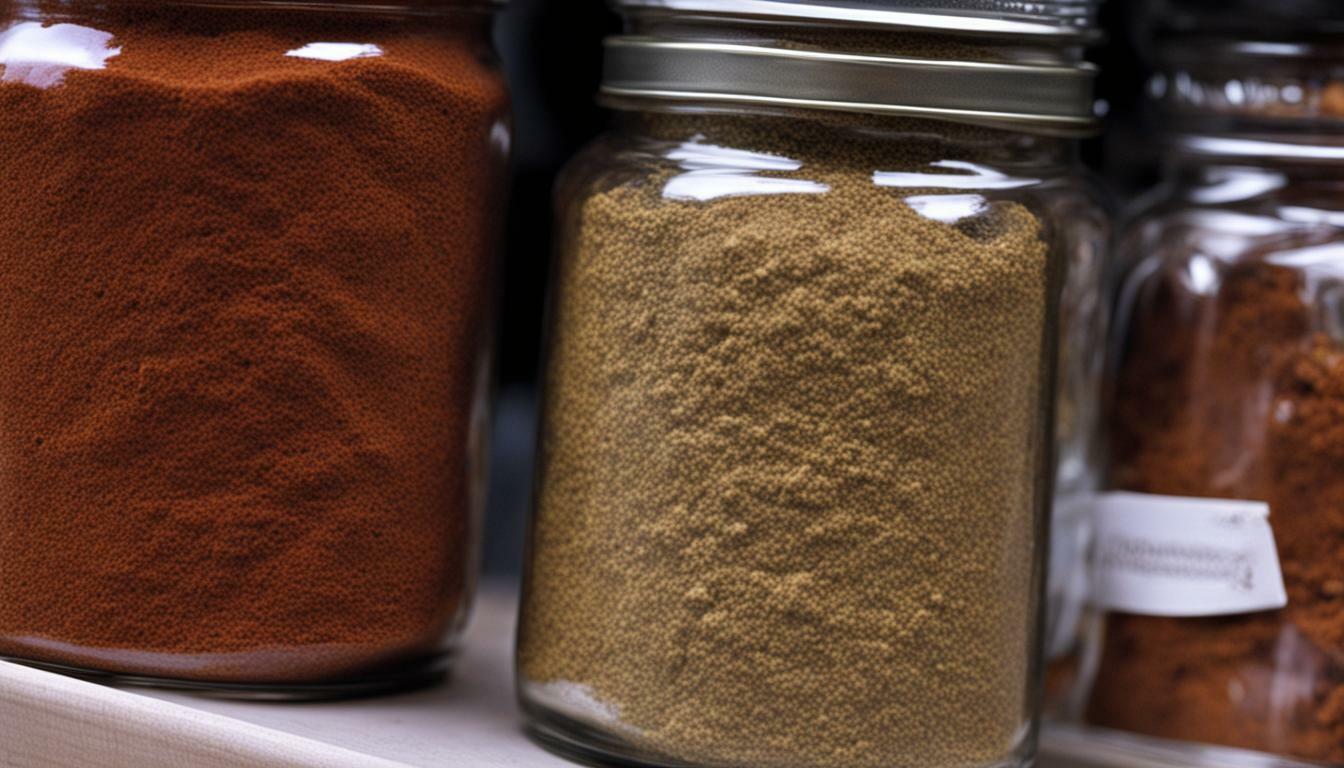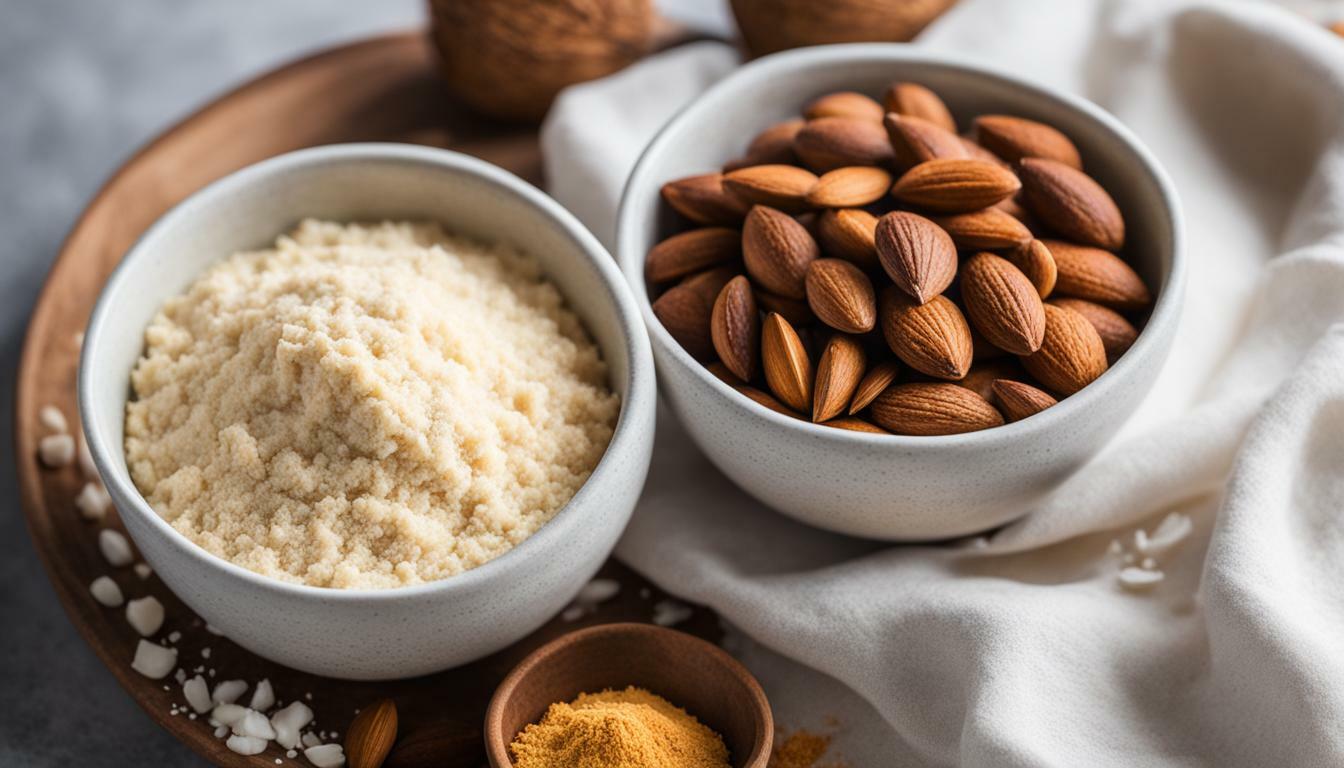Spices are essential ingredients in cooking and baking, adding flavor, aroma, and depth to dishes. Cinnamon and nutmeg are two popular spices that are widely used in various recipes. While they may seem similar at first glance, there are distinct differences between them. In this section, we will explore the origins, flavor profiles, and uses of cinnamon and nutmeg to help you understand how they differ.
Key Takeaways:
- Cinnamon and nutmeg are two popular spices that differ in their origins, flavor profiles, and uses.
- Cinnamon is derived from the bark of the Cinnamomum family trees, while nutmeg comes from the seeds of the Myristica fragrans tree.
- Cinnamon has a warm, sweet, and slightly spicy flavor, while nutmeg has a more pungent and slightly bitter taste.
- Cinnamon is commonly used in baking, while nutmeg is often added to sauces, soups, and vegetable dishes.
- Both spices offer nutritional benefits and have been used in traditional medicine for their potential health properties.
Origins of Cinnamon and Nutmeg
Understanding the origins of cinnamon and nutmeg sheds light on their distinct characteristics. Cinnamon comes from the bark of trees belonging to the Cinnamomum family, primarily found in Sri Lanka and other tropical regions. On the other hand, nutmeg comes from the seeds of the Myristica fragrans tree, which is native to Indonesia and the Spice Islands.
Cinnamon is harvested by peeling off the outer bark of the tree and then scraping off the inner bark. The inner bark is then dried and rolled into cinnamon sticks or ground into powder. Nutmeg, on the other hand, is obtained by removing the outer shell of the nutmeg fruit and drying the seed inside.
Their unique origins give cinnamon and nutmeg their distinctive aromas, flavors, and culinary uses.
Flavor Profiles of Cinnamon and Nutmeg
When it comes to comparing cinnamon and nutmeg, their flavor profiles are a key differentiating factor in their use in cooking and baking.
Cinnamon: This warm and sweet spice has a slightly spicy taste with a hint of citrus notes. Its aroma is distinct and adds a touch of sweetness to dishes. Cinnamon is commonly used in baking, such as in cinnamon rolls, apple pies, and cookies. It is also added to warm beverages like hot chocolate and mulled wine. In savory dishes, it is used in curries, stews, and marinades to add a warm and aromatic flavor.
Nutmeg: Nutmeg, on the other hand, has a pungent and slightly bitter flavor. It is often described as warm, woody, and slightly sweet. Nutmeg is popularly used in baking, especially in dishes like pumpkin pie, gingerbread, and custards. It is also commonly used in creamy sauces, soups, and vegetable dishes. Additionally, it is a key ingredient in festive drinks like eggnog.
Each spice has its own unique flavor profile, which contributes to their different uses. Experimenting with both spices in various recipes can help uncover the best uses for each, allowing you to enjoy a world of flavors in your cooking and baking.
Uses of Cinnamon
Cinnamon is an extremely versatile spice that is used for a wide range of applications, both sweet and savory. Some of the most popular uses of cinnamon include:
- Adding to baked goods, such as cinnamon rolls, cookies, and apple pie, for a warm and sweet flavor.
- Incorporating into warm beverages, such as hot chocolate and mulled wine, for a comforting and aromatic aroma.
- Seasoning in savory dishes, such as curries, stews, and marinades, for a warm and spicy taste.
- Sprinkling on oatmeal, yogurt, or other breakfast foods for added sweetness and warm flavor.
The unique flavor of cinnamon makes it a staple in many kitchens, and its versatility means it can be used in a wide range of dishes. Whether you’re cooking up a sweet treat or a savory dish, cinnamon is definitely a spice to keep on hand.
Uses of Nutmeg
Nutmeg is a versatile spice that can be used in a variety of sweet and savory dishes. Its warm and slightly sweet flavor makes it a favorite in baking, where it is commonly used in dishes like pumpkin pie, gingerbread, and custards. It can also be added to creamy sauces, soups, and vegetable dishes to add a depth of flavor.
In addition to its culinary uses, nutmeg offers some potential health benefits. It contains essential oils that may have antibacterial properties, and has been used in traditional medicine to treat a range of ailments from digestive issues to anxiety.
Overall, nutmeg is a great spice to experiment with in the kitchen. Its unique flavor and potential health benefits make it a versatile addition to any spice rack.
Nutritional Benefits and Culinary Advantages
Beyond their distinct flavors, both cinnamon and nutmeg offer some nutritional benefits. Cinnamon contains antioxidants and has been linked to potential anti-inflammatory and blood sugar regulation properties. It also has a high concentration of cinnamaldehyde, a compound that gives it its characteristic flavor and aroma, as well as potential health benefits. Nutmeg, on the other hand, contains essential oils that may have antibacterial properties, making it a popular ingredient in traditional medicine. Both spices offer unique culinary advantages that make them versatile in cooking and baking.
Which is Better – Cinnamon or Nutmeg?
When it comes to the question of whether cinnamon or nutmeg is better, the answer is not straightforward. It ultimately depends on the personal preference of the cook and the dish being prepared.
Cinnamon is a widely used spice that is loved for its sweet and warm flavor. It is a staple in many kitchens, used in both sweet and savory dishes. However, nutmeg offers a distinct woody and slightly bitter taste that adds a unique depth to dishes. It is also a versatile spice that can be used in both sweet and savory dishes.
To determine which spice is better for a particular recipe, it’s best to experiment with both and let your taste buds be the judge. Cinnamon may be the better choice for dishes that require a sweet and warm flavor, while nutmeg may be better suited for those that need a more pungent and slightly bitter taste.
Ultimately, both cinnamon and nutmeg have their own unique characteristics and culinary advantages. Experimenting with these spices can help uncover their best uses, allowing you to enjoy a world of flavors in your cooking and baking.
So, the next time you’re deciding between cinnamon and nutmeg, don’t be afraid to try both and see which one elevates your dish to the next level.
Conclusion
Cinnamon and nutmeg are two popular spices that offer distinct flavor profiles and culinary advantages. Cinnamon is widely used for its warm and sweet taste, while nutmeg has a more pungent and slightly bitter flavor. Understanding the differences between the two spices can help cooks and bakers decide which spice to use in different recipes.
While cinnamon is often used in baking, it can also be added to warm beverages and savory dishes. Nutmeg, on the other hand, is popular in sweet baked goods but can also be added to soups, sauces, and vegetable dishes. Both spices offer potential health benefits beyond their culinary uses, making them excellent additions to any kitchen.
So, which spice is better – cinnamon or nutmeg? The answer ultimately depends on personal preference and the dish being prepared. Experimenting with both spices can help uncover their unique flavors and discover which one enhances a particular recipe. Whether using cinnamon or nutmeg, incorporating these spices into dishes can add an extra layer of warmth and flavor.
Overall, cinnamon and nutmeg offer a world of flavors to explore in cooking and baking. By incorporating these spices into recipes, individuals can discover new tastes while also enjoying their potential health benefits.
 Skip to main content
Skip to main content


